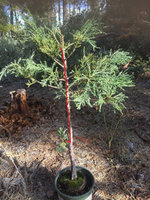@Syedabrar
You found the "ultimate references" in that Craig Cousins, the artist in the Bonsai Empire article has (had) one of the best known sequoia bonsai. Notice, that neither the Bonsai Empire article, nor the giant-sequoia.com website mention "Trunk CHopping" a sequoia. I believe trunk chopping would be ill advised.
If your tree was mine, I would keep it tall, I would not attempt reducing the height as you initially proposed. They are giant trees, and even as bonsai tend to be large trees.
However if you do want to reduce the height, I suggest you "jinn" the top, rather than cut it off. Remove the bark from the point at which you intended to cut at, and strip the bark of upwards to the top.. Allow the created deadwood to dry out, then reduce and carve the deadwood feature to fit with the scale and design of your future tree. Initially start with deadwood feature being much longer than the design calls for, you can always reduce the deadwood later. It is difficult to add the deadwood back if you cut it too short initially.
The reason to create deadwood instead of a typical pruning chop is that the wound healing and growth pattern of sequoia is similar to juniper, and for that matter bald cypress, dawn redwood and coast redwood.
Flush cuts do not heal over very rapidly at all. Decades are needed. Slowly as the trunk expands, it may cover the wound where a branch or trunk was cut flush, but usually the wound remains. Callus does not roll over the flush cut the way it would in an apple tree or an oak tree. In junipers, we handle this by creating deadwood features, jin, as the wound would otherwise always be there, the tool marks of the flush cut stump always being a reminder that the "hand of man" was used to create the image. Deadwood features can be made to look natural enough that the "hand of man" is disguised. In bald cypress and dawn redwood, such flush cuts are carved deeper to create "uro" or hollows in the trunk. I haven't work with coast redwood, so I am not very familiar with their wound healing pattern, but because of their relationship with the others, I assume they respond like bald cypress and dawn redwood.
So if you do want to reduce the height, don't "trunk chop", instead create a long jin (deadwood feature).

 Thanks in Advance.
Thanks in Advance.
 Thanks in Advance.
Thanks in Advance.


